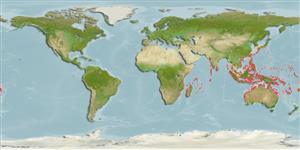Actinopterygii (ray-finned fishes) >
Perciformes (Perch-likes) >
Latidae (Lates perches)
Etymology: Psammoperca: Greek, psammos = sand + Greek,perke = perch (Ref. 45335).
Environment / Climate / Range
Ecology
Marine; brackish; reef-associated; depth range 3 - 12 m (Ref. 90102). Tropical, preferred ?
Indo-West Pacific: Bay of Bengal, Indo-Australian Archipelago and northern Australia to the Philippines, China Sea and Japan (Ref. 2334). Found in the Mekong delta (Ref. 12693).
Length at first maturity / Size / Weight / Age
Maturity: Lm ?, range 28 - ? cm
Max length : 47.0 cm TL male/unsexed; (Ref. 2334); common length : 25.0 cm TL male/unsexed; (Ref. 9799)
Dorsal
spines
(total): 7 - 8;
Dorsal
soft rays
(total): 12-14;
Anal
spines: 3;
Anal
soft rays: 8 - 9. One large flat spine at rear angle of preoperculum. Color varies from light silvery gray to dark brown; eyes reddish. Lateral line extends onto caudal fin.
Inhabits rocky or coral reefs, frequently in weedy areas, usually in holes and crevices by day. Enters estuaries (Ref. 4833). Forages on fishes and crustaceans at night (Ref. 9710). Mainly marketed fresh. In Hong Kong sold live in fish markets (Ref. 27253).
Life cycle and mating behavior
Maturity | Reproduction | Spawning | Eggs | Fecundity | Larvae
Randall, J.E., G.R. Allen and R.C. Steene, 1990. Fishes of the Great Barrier Reef and Coral Sea. University of Hawaii Press, Honolulu, Hawaii. 506 p. (Ref. 2334)
IUCN Red List Status (Ref. 115185)
CITES (Ref. 94142)
Not Evaluated
Threat to humans
Harmless
Human uses
Fisheries: commercial; gamefish: yes
More information
ReferencesAquacultureAquaculture profileStrainsGeneticsAllele frequenciesHeritabilityDiseasesProcessingMass conversion
Tools
Special reports
Download XML
Internet sources
Estimates of some properties based on models
Phylogenetic diversity index (Ref.
82805): PD
50 = 1.0001 [Uniqueness, from 0.5 = low to 2.0 = high].
Bayesian length-weight: a=0.01023 (0.00511 - 0.02050), b=3.04 (2.86 - 3.22), in cm Total Length, based on LWR estimates for this (Sub)family-body shape (Ref.
93245).
Trophic Level (Ref.
69278): 4.0 ±0.67 se; Based on food items.
Resilience (Ref.
69278): High, minimum population doubling time less than 15 months (Preliminary K or Fecundity.).
Vulnerability (Ref.
59153): Low to moderate vulnerability (29 of 100) .
